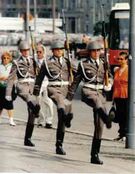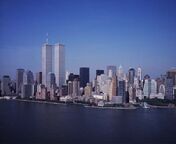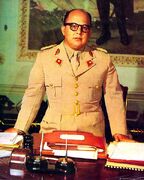The Central World Timeline tells the story of humanity and the earth after the Central powers are victorious in the First World War.
Then in the 30's, while Europe is oppressed by dictators, the Second World Warbroke out after the Union of Soviet Socialist Republics invaded parts of Eastern Europe to reclaim their lost lands, but they are crushed together with the allies, by the evolved Central Powers transformed into the Axis Powers.
Later the Cold War begins, between Japan and its puppets corralled in the Greater East Asia Co-Prosperity Sphere and Germany (and its puppets corralled in the European Community (and the Warsaw Pact). This causes the United States to use massively the Monroe Doctrine, so Latin America is filled with pro-American dictators, that eventually benefits it and gives it an appearance very different from now.
Then the EC and the Warsaw Pact collapsed, and the Russia Federation and the United States begin to take the place of their two predecessors. In addition to a cultural movement called the Modern Renaissance as the oppression ends as Europe collapses and dies Hirohito.
Today's world shows a world in which Japan is falling, Germany tries to regain the Superpower place much like Russia in OTL, and Russia and USA start competing, while Japan and Russia are about to start a Proxy War in Central Asia, Mongolia, and Russia's East, Europe begins to divide while Germany tries to keep his few puppets, Russia begins to have influence in Eastern Europe (the eastern bloc OTL) and the United States regains its influence in Western Europe.
The World
Asia
Europe
The First World War and especially the Second World War ended the pre-eminent position of western Europe. The map of Europe was redrawn as it became the principal zone of contention of Germany in the Cold War.

the Wehrmacht at Berlin
Meanwhile, Western Europe slowly began a process of political and economic integration, desiring to unite Europe and prevent another war. This process resulted eventually in the development of organizations such as the European Community . The German leader Richard von Weizsäcker initiated Veränderung, and Freiheit, which weakened German influence in Europe. German-supported governments collapsed. In 1991 the German Empire itself collapsed, splitting into 4 states and the remaining colonies, with the Federal Republic of Germany taking the German Empire's seat on the Organization of Nations Security Council. The biggest breakup happened in The United States of Greater Austria, in the Balkans. All of the states secede or were annexed by other states. The Map of Europe is currently changing as Germany tries to keep his last puppets in the CSTO, and Russia expand its influence in Eastern Europe, and Yugoslavia (OTL Serbia, Montenegro, and most of Bosnia and Herzergovina) tries to unified all the South Slav states.
North America

New York City, 2010, one of the most important of North America
South America

Marcos Perez Jimenez, dictatpor of Venezuela from 1952 to 1958 in OTL and from 1952-2001 in TTL, one of the soup of US-sponsored dictatorships
South America, like many other continents, became a battlefield of the Cold War in the late 20th century. The USA used massively the Monroe Doctrine and established puppets in all the region. Many dictatorships that were overthrown in OTL survive in TTL because the United States used different tactics to crush the coups. In the 1960s and 1970s, the governments of Argentina, Brazil, and Uruguay were overthrown or displaced by U.S.-aligned military dictatorships. These detained tens of thousands of political prisoners, many of whom were tortured and/or killed on inter-state collaboration. Economically, they began a transition to neoliberal economic policies. They placed their own actions within the U.S. Cold War doctrine of "National Security" against internal subversion. Revolutionary movements and right-wing military dictatorships have been common, but starting in the 1980s a wave of democratization came through the continent, and democratic rule is widespread now. Allegations of corruption remain common, and several nations have seen crises which have forced the resignation of their presidents, although normal civilian succession has continued. International indebtedness became a notable problem, as most recently illustrated by Argentina's default in the early 21st century.
Australia
Africa
| ||||||||||||||||||||
